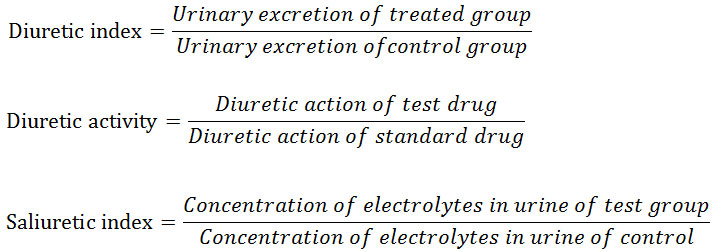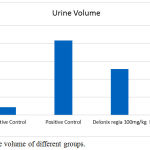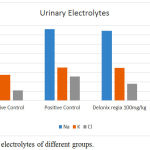Jayanthi M K1 and Siddamma Amoghimath2
1Department of Pharmacology, JSS Medical College, Mysuru, Karnataka, India.
2Department of Pharmacology, Gadag Institute of Medical Sciences, Karnataka, India.
Corresponding Author E-mail: siddama.a@gmail.com
DOI : https://dx.doi.org/10.13005/bpj/1454
Abstract
To study the diuretic activity in ethanolic extract of leaves of delonix regia in wistar albino rats. After obtaining the permission from the Institutional Ethical Committee (IAEC) Wistar albino rats were randomly selected and divided into 4 groups. The animals were fasted and deprived of food and water 20hrs prior to the experiment. On the day of experimentation, Group 1 negative control received Normal saline (25ml/kg), Group 2 positive control received Furosemide 20mg/kg body weight, and Group 3 received ethanonic extract of delonix regia 100mg/kg and Group 4 received ethanonic extract of delonix regia 200 mg/kg. Delonix regia increase the excretion of sodium and water at the dose of 100mg/kg and 200mg/kg of body weight. The diuretic index is 5.93 and 6.45 at 100mg/kg and 200mg/kg of delonix regia respectively. The diuretic activity if delonix regia 100mg/kg is 0.61 and 0.67 at dose 200mg/kg, which is more than that of negative control but less when compared to positive control. Ethanonic extract of Delonix regia showed significant diuretic activity at both 100mg/kg and 200mg/kg doses.
Keywords
Delonix Regia; Diuretic; Ethanolic; Furosemide
Download this article as:| Copy the following to cite this article: Jayanthi M. K, Amoghimath S. To Evaluate the Diuretic Activity in Ethanolic Extract of Leaves of Delonix Regia in Wistar Albino Rats. Biomed Pharmacol J 2018;11(2). |
| Copy the following to cite this URL: Jayanthi M. K, Amoghimath S. To Evaluate the Diuretic Activity in Ethanolic Extract of Leaves of Delonix Regia in Wistar Albino Rats. Biomed Pharmacol J 2018;11(2). Available from: http://biomedpharmajournal.org/?p=20992 |
Introduction
Diuretics are the drugs which cause increase in urinary output of electrolytes and water from the kidney. The net loss of sodium and water in the urine is due to one or more reabsorptive processes occurring at different segments of the nephron. The increase water loss is actually secondary to the increased excretion of sodium chloride. This is achieved either by directly acting on different segments of the nephron or by indirectly modifying the contents of the urinary filtrate.1
Diuretics are prescribed in various conditions like congestive heart failure, cirrhosis of liver, nephrotic syndrome, hypertension, hyperkalemia, to treat ingestion of toxic anions etc. likewise the adverse effects of diuretics are hyperuricemia, hypercalciuria, hypomagnesaemia, hypokalemia, ototoxicity, hyperglycemia, erectile dysfunction, hypersensitivity reactions etc.[1]
Hence, the search for better drugs with lesser adverse effects, which are more efficacious and economical is need of the hour. Plants are source for various drugs. They offer an untapped potential for newer drugs.
Delonix regia (Gul Mohr) is a species of flowering plant from the Fabaceae family, Caesalpinioideae sub-family, noted for its fern-like leaves, flamboyant display of flowers native to Madagascar. The tree is distributed in various region s of India, Africa, and North Australia. In many tropical parts of countries around the world it is grown as an ornamental tree and in English it is given the name Royal Poinciana or Flamboyant. It is also known as Flame tree. The tree reaches upto 40 feet height with the red orange flowers. The flowers are large, with four spreading scarlet or orange-red petals upto 8 cm long, and a fifth upright petal called the standard, which is slightly larger and spotted with yellow and white. Seedpods are dark brown and can be up- to 60 cm long and 5 cm wide; the individual seeds, however, are small, weighing around 0.4 g on average. The compound leaves have a feathery appearance and are a characteristic light, bright green. They are doubly pinnate. Each leaf is 30–50 cm long and has 20 to 40 pairs of primary leaflets or pinnae on it, and each of these is further divided into 10-20 pairs of secondary leaflets or pinnacle’s. [2, 3, 4] The seeds, leaves, flowers and the barks contain active phyto-constituents and are known to have various activities like anti-ulcer, anti-inflammatory, anti-fungal, anti-helminthic, and cytotoxic activities. [5, 6, 7, 8] Traditionally the leaves are used for bronchitis, and pneumonia in infants, anti-diabetic, gastric problems and rheumatic joint pains 9, 10. Studies conducted earlier have shown that it have phyto-constituents such as flavinoids, Triterpenoidal saponins, sterols, organic acids, etc. Ethanolic and methanolic extract of the flowers has been evaluated for diuretic property. [11, 12, 13, 14, 15, 16]
Hypothesis
Thus it may be hypothesized that the diuretic activity of ethanolic extract of Delonix regia may be due to flavonoids, saponins and sterols.
Materials and Methods
The study was conducted at Central Animal Facility and all animals care and experimental protocols were approved by the Institutional Animal Ethics Committee (IAEC).
Extraction of Plant Material
About 500grams of leaves was collected, washed and dried in hot air oven. After drying they were put in 1000ml soxhlet apparatus and extracted with ethanol for 1 day. The extract is dried in air and powdered later.
Animals
Wistar albino rats of either sex of average weight 150-200gms aged 3-4 months were used in the experiments. The rats were inbred in the central animal house, under suitable conditions of housing, temperature, ventilation and nutrition. Rats were housed two to three per stainless cage under conventional conditions. They were kept at a constant temperature of 26±20C and relative humidity of 30-70% under a 12 h dark/ light cycle. The rats were acclimatized to the laboratory conditions for seven days prior to test before assigning animals to treatment group. The dose of extract were based on the pilot study.
Inclusion Criteria
Rats weighing 150-200gms either sex
Age 3-4 months.
Healthy with normal behaviour and activity.
Exclusion criteria
Pregnant animals.
Diseased animals.
Method of Collection of Data
In this study 24 albino rats (4 groups each containing 6 rats) are required for the main study.
The study groups will be divided as follows;
Group-1 (negative control): Normal saline 25ml/kg body wt.
Group-2 (positive control): furosemide 20mg/kg body weight
Group-3 (test 1): 100mg/kg of ethanolic extract of leaves of delonix regia
Group-4 (test 2): 200mg/kg of ethanolic extract of leaves of delonix regia
All the above drugs were given per orally. And the dose of ethanolic extracts of Delonix regia was determined after pilot study.
Instruments Required
Diuretic cages, oral feeding tube, glass beaker, syringes
Chemicals
Furosemide (Tab Lasix 40mg, Sanofi Aventis Pharmaceuticals, India), Normal saline.
Models and Methodolgy of Experiment
The diuretic activity was evaluated by Lipschitz model. 17 In this model Wistar albino rats weighing 100-200g are used. The animals were fasted and deprived of food and water for 20hrs prior to the experiment. On the day of experiment, the Group I animals serving as negative control, received Normal saline (25ml/kg) per orally, the Group II serving as positive control animals received Furosemide 20mg/kg body weight per orally, Group III received 100mg/kg ethanolic extract of Delonix regia leaves per orally and Group IV received 200mg/kg ethanolic extract of Moringa oliefera3 per orally. Immediately after the administration the animals were kept in diuretic cages (3 per cage) specially designed to separate urine and fecal matter and kept at room temperature of 25 ± 0.5º C throughout the experiment. The total volume of urine was collected at the end of 5hrs after dosing. During this period no water and food was made available to animals. The urine volume was measured and will be expressed in ml/5h. The concentrations of the electrolytes Na+, K+ (cations), in urine will be expressed in terms of mmol/L. Diuretic index and diuretic activity will be calculated as,

Statistical Analysis
The results was analyzed by calculating the Mean and Standard Deviation. For multiple group comparison one way analysis of variance (ANOVA) followed by Post-hoc Scheffe’ test for statistical significance between groups. The values was compared at 0.05 level of significance. P < 0.05 was considered as significant. All the results were analyzed by IBM SPSS statistics ©IBM Corporation and Other(s) 1989, 2012 software was used for statistical analysis purpose.
Results and Discussion
Delonix regia leaves contains various phyto constituents such as flavonoids, tannins, triterpenoidal saponin, sterols. Various studies have explained that these active phyto ingredients are responsible for its activities.
Diuretics are useful in variety of conditions such as congestive heart diseases, nephritis, nephritic syndrome, pregnancy, premenstrual tension, hypertension, pulmonary edema, mountain sickness, etc. Various side effects are associated with the present generation of diuretics. Loop diuretics can cause hyponatremia, hypokalemia, hypotension, hyperuricemia precipitating gout, etc. thiazide diuretics can cause hyponatremia, hypokalemia, precipitate encephalopathy in severe liver compromise, erectile dysfunction, etc. aldosterone antagonists can cause hyperkalemia, gynaecomastia, etc.
In the present study diuretic activity of ethanolic extract of Delonix regia was evaluated with the positive control furosemide and the negative control Normal saline. The dose of ethanolic extract of Delonix regia was 100mg/kg and 200mg/kg. At the end of 5 hours, the amount of urine collected in positive control furosemide (20mg/kg ) group was 20.8ml, negative control (Normal saline) group was 2.16ml, test 1 Delonix regia (100mg/kg) was 12.81ml and test 2 Delonix regia 200mg/kg was 13.95ml respectively (Table 1 & Graph 1).
Table 1: Showing urine volume, urinary electrolytes and sailuretic index of different groups.
| Urine volume | Na+ | K+ | Cl– | Sailuretic index | ||
| Na+ | K+ | |||||
| Negative control | 2.16±0.32 | 136.33±3.72 | 54.66±4.54 | 22±3.94 | —– | —— |
| Positive control | 20.8±0.94 | 152±4.14 | 70.1±3.43 | 51±3.16 | 1.11 | 1.28 |
| Delonix regia 100mg/kg | 12.81±1.61⃰ | 149±2.36⃰ | 69.83±2.48⃰ | 36±3.16⃰ | 1.09 | 1.27 |
| Delonix regia 200mg/kg | 13.95±0.76⃰ | 150.66±2.73⃰ | 70.33±2.94⃰ | 39.66±4.76⃰ | 1.10 | 1.28 |
Data is expressed in mean±SD, ⃰ P<0/05 is considered as significant.
Urine volume is expressed as ml/kg
Urinary electrolytes is expressed as mmol/ L
 |
Graph 1: Shows urine volume of different groups.
|
The electrolytes in the urine was estimated. In positive control furosemide group , the sodium concentration was 152mmol/L, potassium was 70.16mmol/L, chloride was 51mmol/L. In negative control (Normal saline) the sodium concentration was 136.33mmol/L, potassium was 54.66 mmol/L, and chloride was 22 mmol/L. In test group 1 delonix regia (100mg/kg) the sodium concentration was 149 mmol/L, potassium concentration was 69.83 mmol/L, chloride concentration was 36 mmol/L. In test group 2 delonix regia (200mg/kg) the sodium concentration was 150.66 mmol/L, potassium concentration was 70.33 mmol/L and chloride concentration was 39.66 mmol/L (Table 1& Graph 2).
Table 2: Showing the diuretic index and diuretic activity of various groups
| Group | Diuretic index | Diuretic activity |
| NEGATIVE CONTROL | —– | —– |
| POSITIVE CONTROL | 9.62 | —– |
| DELONIX REGIA 100MG/KG | 5.93 | 0.61 |
| DELONIX REGIA 200MG/KG | 6.45 | 0.67 |
 |
Graph 2: Shows urine electrolytes of different groups.
|
Table 2 showed the diuretic index and diuretic activity of test drug and positive control when compared to negative control. The diuretic index of positive control is 9.62, test group 1 is 5.93 and test group 2 is 6.45. Diuretic index value of >1.5 indicates a good diuretic activity. And diuretic index value of 1.0-1.5 indicates moderate diuretic activity, diuretic index of 0.72-0.99 demonstrate mild diuretic activity. In the present study the diuretic index value of delonix regia 100mg/kg and 200mg/kg was 5.93 and 6.45 respectively. Thus the extract of delonix regia 100mg/kg showed 61% and delonix regia 200mg/kg showed 67% diuretic activity when compared to positive control furosemide.
Traditionally different parts are used for treating various diseases. Likewise, the bark is used for menorrhagia, rheumatism, flatulence, the plant is used as CNS depressant, in treatment of anaemia and fever. Flowers are used in treatment of dysmenorrhea, inflammation and diarrhea. Leaves are used for bronchitis and pneumonia, diabetes, gastric problems and rheumatic arthritis. The root is used for abdominal pain.
The delonix regia is due to presence of various phytoconstituents in various parts of the tree. Phytoconstituents like flavonoids, phenolic acids, carotene hydrocarbons, ketocaratenoid, pigments, fatty acids, tannins, amino acids, sterols are present and are responsible for its various activities.
The above finding prove that there is need for further fractionation and isolation of secondary phytochemicals responsible for the diuretic activity.
Conclusion
The present study indicates that ethanolic extract of delonix regia is a potential diuretic. However further studies are required to separate the phyto constituents responsible for the diuretic activity and to confirm the safe use in renal disorders.
Acknowledgement
The author(s) received no specific funding for this work.
Conflict of Interest
There is no conflict of interest
References
- Rang H.P, Dale M.M, Ritter J.M, Flower R.J, Henderson G. Rang and Dale’s pharmacology. In: Rang H.P, Dale M.M. The Kidney. Churchill Livingstone Elsevier, China 2012: 347-353.
- Alexandro M M Vargas, Clarice A Garcia, Edson M Reis, Ervim Lenzi, Vitor C Almeida. NaOH-activated carbon from flamboyant (Delonix regia) pods: Optimization of preparation conditions using central composite rotatable design. Chemical Engineering Journal. 2010; 162(1): 43-50.
CrossRef - De Groot H. Reactive oxygen species in tissue injury. Hepatogastroenterology 1994; 41(2): 328-332.
- Deepa B, Remadevi OK. Larvicidal activity of the flowers of Delonix regia (Bojer Ex Hook.) Rafin. (Fabales: Fabaceae) against the Teak defoliator, Hyblaea puera Cramer. Current Biotica. 2011; 5(2): 237-240.
- Parekh J, Jadeja D, Chanda S. Efficacy of aqueous and methanolic extracts of some medicinal plants for potent anti-bacterial activity. Turkish Journal of Biology 2005; 29: 203-210.
- Senthil Velan S, Jeeva Prakash G, Sindhan V, Somasekhar E, Bharathi S, Rajani Evaluation of diuretic activity of Delonix regia (Gul mohr) flowers in albino rats. International Journal of Research in Pharmaceutical Sciences 2012; 3(3): 369-372.
- Modi A, Mishra V, Bhatt A, Jain A, Mansoori MH, Gurnany E, et al. Delonix regia: historic perspectives and modern phytochemical and pharmacological researches. Chinese Journal of Natural Medicines. 2016; 14(1): 0031-0039.
- Ahirao R A, Patel M R, Hamid S, Tadavi S A. In vitro anthelminthic property of various herbal plants extracts against Pheritima posthuma. Pharmacologyonline. 2011; 2: 542-547.
- Sethuraman M G, Sulochana N. The anti-inflammatory activity of Delonix elata. Current Science. 1986; 55: 343-344.
- Samar S Azab, Mohamed Abdel-Daim, Omayma A Eldahshan. Phytochemical, cytotoxic, hepatoprotective and anti-oxidant properties of delonix regia leaves extract. Medicinal Chemistry Research. 2013; 22(9): 4269-4277.
CrossRef - D K Pandey, H Chandra, N N Tripathi. Volatile fungitoxic activity of some higher plants with special reference to that of Callistemon laceolatus DC. Journal of Phytopathology. 1982; 105(2): 175-182.
CrossRef - P Maria Jancy Rani, P S M Kannan, S Kumaravel. Screening of antioxidant activity, total phenols and gas chromatograph and mass spectometer (GC-MS) study of delonix regia. African Journal of Biochemistry Research. 2011; 5(12): 341-347.
- Mahafuzar Rahman Md, Nazmul Hasan Md, Asish Kumar Das, Tozammal Hossain Md, Rownak Jahan, Afsana Khatun, et al. Effect of delonix regia leaf extract on glucose tolerance in glucose induced hyperglycemia African Journal of Traditional, Complementary and Alternative Medicines. 2011; 8(1): 34-36.
- Shewale V D, Deshmukh T A, Patil L S, Patil V R. Anti-inflammatory activity of delonix regia . Advances in Pharmacological Sciences. 2012; 5(3): 1-4.
CrossRef - Chai WM, Shi Y, Feng HL, Qiu L, Zhou H C, Deng Z W, et al. NMR, HPLC-ESI-MS, and MALDI-TOF MS analysis of condensed Tannins from Delonix regia (Bojer ex Hook.) Raf. and their bioactivities. Journal Agricultural and Food Chemistry. 2012; 60(19): 5013-5022.
CrossRef - Mariajancyrani Prakash, Chandramohan Govindswamy, Ravikumar Raju, Fathima Beevi. Isolation and antibacterial activity of oleananoic acid acetate from Delonix regia leaves. Journal of Pharmacy Research. 2013; 6(4): 423-425.
CrossRef - Werner L Lipschitz, Zareh Hadidian, Andrew Kerpcsar. Bioassay of diuretics. Journal of Pharmacology and Experimental Therapeutics. 1943; 79(2): 97-110.







